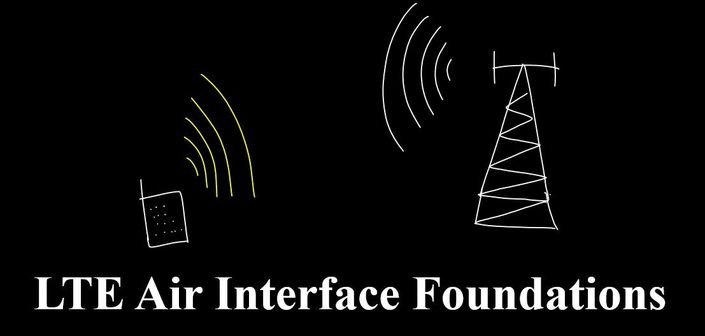
LTE AIR INTERFACE FOUNDATIONS EXPLAINED
Must have Practical knowledge for 4G LTE Air Interface
If you are interested in LTE RF domain and you need to choose just one course, which can give you the balance on how things operate in LTE Air Interface? Your best bet is to learn about LTE Air Interface Foundations.
This course is your one shop stop in order to learn quickly about:
- LTE Air Interface,
- Channel mapping in LTE air interface,
- Control and data regions in LTE air interface.
This course assumes you already have a basic understanding of cellular network and wireless communications.
OVERVIEW
The course is divided into 12 modules. 8 Core modules and 4 Bonus Modules:
MODULE # 1: FUNDAMENTAL LTE OVERVIEW
MODULE # 2: LTE RADIO FRAME
MODULE # 3: LTE RADIO FRAME, SCHEDULING BLOCK VISUALIZATION
MODULE # 4: HOW TO CALCULATE THROUGHPUT IN LTE?
MODULE # 5: CONTROL, DATA REGIONS AND CHANNEL MAPPING IN LTE
MODULE # 6: CASE STUDY: TEST YOUR KNOWLEDGE
MODULE # 7: DISTRIBUTION OF CONTROL CHANNELS IN LTE
MODULE # 8: LTE UPLINK RADIO FRAME OVERVIEW
BONUS MODULES
MODULE # 9: BONUS NO.1 : EPS BEARER CONCEPT AND QUALITY OF SERVICE IN LTE
MODULE # 10: BONUS NO.2: MOBILITY OVERVIEW IN LTE
MODULE # 11: BONUS NO. 3: MULTI-ANTENNA SCHEMES IN LTE
MODULE # 12: BONUS NO. 4: CONNECTING THE DOTS
WHAT ARE THE REQUIREMENTS ?
Participants should have understanding of the following:
- Have basic understanding of how any wireless or communication network operates
- Have concept of node(s), radio access networks (RAN) and core network (CN).
- The course is a mix of text format and video modules to help you ace up and review concepts quickly.
IN ORDER TO GET MAXIMUM BENEFIT FROM THIS COURSE
- The prerequisite for this course is that you need to be familiar with understanding of 4G LTE architecture and its operation.
WHO IS THIS COURSE FOR ?
The course is for NOT FOR EVERYONE.
This course is NOT for you if you do not have basic understanding and knowledge of a cellular network operation.
This course is for: individuals who are currently working or planning to work in LTE RF domain.
COURSE DESCRIPTION :
If you are trying to learn LTE and don’t know where to start. You are asking questions:
- What procedures take place on LTE Air Interface?
- What procedures are triggered in EPS network and how?
- How scheduling takes place in Uplink and Downlink ?
- What channels are in LTE Air Interface?
- How Channel mapping takes place in LTE?
This comprehensive course reveals in depth information on LTE air interface, in terms of technology, channel mapping and procedures. It provides detailed description on LTE Radio interface, its structure. Physical layer procedures such channel coding, modulation, resource blocks, signaling procedures and scheduling both in UL and DL.
LTE Knowledge and Learning Objectives:
On completion of this training. You will become familiar and be able to understand and grasp the following topics for LTE:
MODULE # 1: FUNDAMENTAL LTE OVERVIEW
- Control Plane Stack in LTE
- User Plane Stack in LTE
- FDD and TDD in LTE
- Frequency bands for LTE
MODULE # 2: LTE RADIO FRAME
- Learn about LTE Radio Frame
- Explain the Time Domain Aspects of LTE Radio Frame
- Understand the frequency domain aspects of LTE Radio Frames
- Learn the concept of subcarriers in LTE Radio Frame
- Explain the concept of symbols in LTE Radio Frame
MODULE # 3: RADIO FRAME, SCHEDULING BLOCK REALIZATION
- Explain the concept of Resource Block and Scheduling Block in LTE
- Learn how to visualize a scheduling block in an LTE radio frame
- Understand specific 5 MHz market LTE Radio Frame
- Visualize and understand the distribution of resources in time and frequency domain
MODULE # 4 : HOW TO CALCULATE THROUGHPUT IN LTE?
- Compute theoretical throughput calculation in LTE Downlink
- Understand the assumptions in calculating the throughput
- Complete the exercise to compute throughput on your own
- UE categories and Modulation in LTE: How UE Categories affect the Throughput you receive?
MODULE # 5: CONTROL, DATA REGIONS AND CHANNEL MAPPING IN LTE
- Control Region and Data Region in LTE Air Interface
- Learn about Radio Interface and Radio Access Network (RAN) Protocols
- Understand Channel Mapping in LTE Air Interface
- Learn about Logical channels in LTE
- Explain Physical Channel in LTE Air
- Understand DL Channel Mapping
- Understand UL Channel Mapping
MODULE # 6 : CASE STUDY: TEST YOUR KNOWLEDGE
- Learn How to use LTE Air Interface channels for UE Attach
- Perform UE Attach using LTE Air Interface channel mapping
- List the responsibilities of each channel
- Learn the sequence how each channel is used during Attach procedure
MODULE # 7: DISTRIBUTION OF CONTROL CHANNELS IN LTE
- Learn Details about respective Air Interface channels
- Understand PDCCH Channel
- Learn DCI Formats
- Explain PCFICH Channel
- Learn PHICH Channel
- Understand PDSCH channel
- Learn the concept of Reference signals
MODULE # 8: LTE UPLINK RADIO FRAME OVERVIEW
- Learn about the Overview of Uplink Radio Frame in LTE
MODULE # 9: BONUS NO. 1: EPS BEARER AND QUALITY OF SERVICE IN LTE
- Learn the concept of EPS Bearer in LTE
- Understand How Quality of Service (QoS) concept operates in LTE
MODULE # 10: BONUS NO. 2: MOBILITY OVERVIEW IN LTE
- Learn the Mobility Overview in LTE
MODULE # 11: BONUS NO. 3: MULTI-ANTENNA SCHEMES IN LTE
- Learn Multi-Antenna Schemes in LTE
- Understand the Overview of MIMO operation in LTE
- Explain different MIMO Modes operating in LTE
MODULE # 12: BONUS NO. 4: CONNECTING THE DOTS
- Physical Layer Processing in LTE
- E-UTRAN Architecture with Channel Mapping
